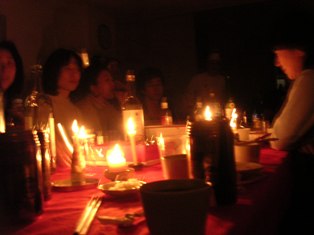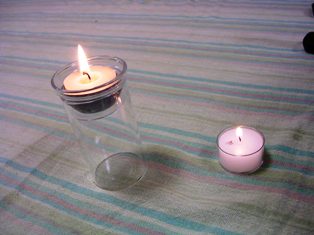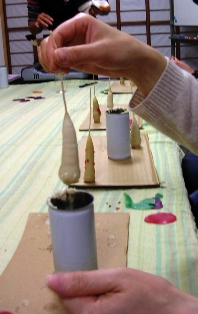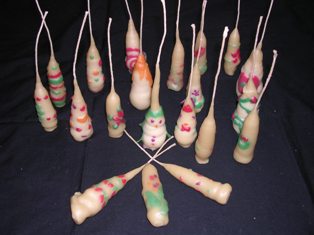
![]()
![]()
![]()
![]()
![]()
![]()
![]()
![]() About Us
About Us
Candle Essay
Candle Stories
Candlescape
Event Information
Message from overseas
News
Newsletter
Report
What's new
![]() Japan Fund for Global Environment (2007.09.30)
Japan Fund for Global Environment (2007.09.30)
2007 Photo Competition--Send your photos! (2007.08.24)
Effects of MOE's "Lights Down" Campaign (2007.08.09)
Candle Night in Taipei 2007 (2007.08.09)
Candle Night in Tokyo 2007 (2007.08.09)
![]()
News Archive
RSS
Edit

News / 03/03/2006 |

2006.03.03
Beeswax candle workshop and volunteer meeting at JFS NL#7
Reporter : english
Japan for Sustainability (JFS) is a non-profit organization created to disseminate information on the environmental initiatives of citizens, businesses and local governments of Japan to the world via e-mail newsletters. Ms. Junko Edahiro, one of the promoters of Candle Night, is also the co-founder of JFS. Using its know-how and network, JFS supports Candle Night as an organization, sending information on the move both in and outside of Japan to the world.
http://www.japanfs.org/index.html
JFS's activities, such as gathering information and translating it into English are supported by many volunteer teams. Because most of the work is done via e-mail and the Internet, the volunteer meetings held several times a year are important occasions to meet in person and communicate with each other.
On the evening of December 23, one night after the winter solstice in 2006, JFS held a Candle Night volunteer meeting. At the meeting, participants enjoyed a variety of dishes cooked by volunteers. They turned off the lights and lit the brand-new beeswax candles made at the workshop that was held prior to the meeting.

Ms. Megu'u Ogata of Yukkurido Co. was an instructor at the workshop. Yukkurido originated from the Sloth Club, whose founder is Mr. Shinichi Tsuji, another Candle Night promoter. Yukkurido intends to nurture "slow" culture, opposite from a culture represented by "fast" life, and to improve the ways of addressing environmental issues from an economic perspective.
http://www.yukkurido.com/
Beeswax candles have distinctive sweet smells, very different from those made from petroleum-derived paraffin. Looking carefully, you can see the colors of the flames are also different. We would like to show you how to make beeswax candles and explain the difference between warousoku (Japanese candles) and candles in general.
What is beeswax?
Beeswax, as you can imagine from the term, is produced when honeybees make honey. It is said that honeybees make hexagon-shaped cells using their antennas as rulers. If you boil honeycomb in water after collecting honey and leave it overnight, the beeswax will be separated from the honeycomb. In Japan, it is said that the first candles were made from beeswax. When Buddhism was introduced to Japan from China, beeswax was introduced as well. At that time, beeswax candles were high-end goods. Ordinary candles were made of pine resin, rolled with the leaves of plants.
The story of "warousoku"--Japanese candles
Japan has its own distinctive candles called warousoku ("wa" means Japanese and "rousoku" means candles), which were made in the Edo Period (1603-1867). Besides beeswax, Japanese candles were also made from plant-derived materials, such as Japanese lacquer trees, Japanese wax trees, and rice bran. One of the distinguishing characteristics of Japanese candles is their shape. They are tall, like a taper, but slightly wider and flat on top. The center of the body is curved slightly inward, making a distinctive line. The reasons are not clear, but someone once said that it is because the wax is applied by the palms of craftsmen. The wick is made from rush fibers, which are wrapped around a bamboo stick. Then, after the wax has dried, the stick is pulled away from the body, making the wick hollow.
Flowers are painted on many Japanese candles because Japanese people enjoy flowers, even during the seasons when flowers are not blooming. This represents part of Japanese views on nature--Japanese people want to feel nature in their daily lives.
Dipping beeswax candles
The flames of beeswax candles are yellowish because the temperature is lower than that made from paraffin.

(left: beeswax right: paraffin)
At this workshop, the participants tried dipping candles, which takes more time than any other candle making technique. The easiest way is to pour melted wax in a paper cup, put in a wick and cool it.
--How to make a beeswax candle--
You will need the following:
Beeswax 150 gram
Cotton wicks
Steamer pot
Dipping can
1. Put beeswax into a dipping can. Fill the water into the steamer pot and warm it. The water level should be half of the dipping can's height.
2. When the water in the steamer pot begins to boil, turn off the burner. Place the dipping can in the pot and melt the beeswax. It melts at 60 to 65 degrees Celsius. If the water begins to cool down, warm it up again.
3. Cut the length of wick as you like. Hold the end of the wick and dip it into the melted beeswax as straight as possible.
4. After one moment, pull the wick out quickly. When the surface of the wax hardens and turns white, re-submerge it. Repeat the process again and again, and build up the wax little by little. When the wax in the dipping can hardens, warm it up and melt the wax again.
After repeating the dipping, the candle creates its own shape. Each candle is unique--one is thick while another may look like a pear.

When it reaches the desired diameter and shape, the candle is decorated with colored beeswax. This process adds a distinguished look to each candle. You can melt shaved crayon into the melted beeswax and color it before dipping.
Twenty people who participated in the workshop say, "It is the first experience for me. I enjoyed it," "I have come to know there are many kinds of wax,""The smell is good, and I like kneading the colored beeswax."

The candle making workshop gives participants an opportunity to use their senses. It may give them a chance to consider their own culture while enjoying the process.
(Staff writer: Yuko Kisikami Photo courtesy: Japan for sustainability)
| english | 09:31 | trackbacks(0) |
Trackback URL: http://admin.candle-night.org/mt/mt-tb.cgi/8 |

